Strong Precipitation and Human Activity Spur Rapid Nitrate Deposition in Estuarine Delta: Multi-Isotope and Auxiliary Data Evidence
Abstract
1. Introduction
2. Materials and Methods
2.1. Introduction to the Study Area
2.2. Sample Collection and Analysis
2.3. ISOsource Model
2.4. Water System and Land Use Data
3. Results and Discussion
3.1. Heavy Rains Changed the Relationship of Surface Water Replenishment
3.2. Heavy Rains Changed the Nitrate Distribution and Promoted Its Rapid Output
3.3. Human Activities Dominate the Source of Surface Water Nitrate in the Yellow River Delta
3.4. Scientific Source Control of NO3−
4. Conclusions
Author Contributions
Funding
Institutional Review Board Statement
Informed Consent Statement
Data Availability Statement
Conflicts of Interest
References
- Pilotti, M.; Barone, L.; Balistrocchi, M.; Valerio, G.; Milanesi, L.; Nizzoli, D. Nutrient delivery efficiency of a combined sewer along a lake challenged by incipient eutrophication. Water Res. 2021, 190, 116727. [Google Scholar] [CrossRef]
- Beusen, A.H.W.; Dekkers, A.L.M.; Bouwman, A.F.; Ludwig, W.; Harrison, J. Estimation of global river transport of sediments and associated particulate C, N, and P. Glob. Biogeochem. Cycles 2005, 19. [Google Scholar] [CrossRef]
- Beusen, A.H.W.; Bouwman, A.F.; Van Beek, L.P.H.; Mogollón, J.M.; Middelburg, J.J. Global riverine N and P transport to ocean increased during the 20th century despite increased retention along the aquatic continuum. Biogeosciences 2016, 13, 2441–2451. [Google Scholar] [CrossRef]
- World Health Organization. Guidelines for Drinking-Water Quality: Fourth Edition Incorporating First Addendum. Available online: https://apps.who.int/iris/handle/10665/254637 (accessed on 15 May 2021).
- Environmental Quality Standards for Surface Water, GB 3838-2002. Available online: http://openstd.samr.gov.cn/bzgk/gb/ (accessed on 18 August 2019).
- Guo, Z.; Yan, C.; Wang, Z.; Xu, F.; Yang, F. Quantitative identification of nitrate sources in a coastal peri-urban watershed using hydrogeochemical indicators and dual isotopes together with the statistical approaches. Chemosphere 2020, 243, 125364. [Google Scholar] [CrossRef]
- Zhang, Y.; Li, F.; Zhang, Q.; Li, J.; Liu, Q. Tracing nitrate pollution sources and transformation in surface- and ground-waters using environmental isotopes. Sci. Total Environ. 2014, 490, 213–222. [Google Scholar] [CrossRef]
- Fadhullah, W.; Yaccob, N.S.; Syakir, M.; Muhammad, S.A.; Yue, F.-J.; Li, S.-L. Nitrate sources and processes in the surface water of a tropical reservoir by stable isotopes and mixing model. Sci. Total Environ. 2020, 700, 134517. [Google Scholar] [CrossRef] [PubMed]
- Zhang, Y.; Shi, P.; Song, J.; Li, Q. Application of Nitrogen and Oxygen Isotopes for Source and Fate Identification of Nitrate Pollution in Surface Water: A Review. Appl. Sci. 2018, 9, 18. [Google Scholar] [CrossRef]
- Xuan, Y.; Tang, C.; Cao, Y. Mechanisms of nitrate accumulation in highly urbanized rivers: Evidence from multi-isotopes in the Pearl River Delta, China. J. Hydrol. 2020, 587, 124924. [Google Scholar] [CrossRef]
- Richards, G.; Gilmore, T.E.; Mittelstet, A.R.; Messer, T.L.; Snow, D.D. Baseflow nitrate dynamics within nested watersheds of an agricultural stream in Nebraska, USA. Agric. Ecosyst. Environ. 2021, 308, 107223. [Google Scholar] [CrossRef]
- Lin, J.; Böhlke, J.K.; Huang, S.; Gonzalez-Meler, M.; Sturchio, N.C. Seasonality of nitrate sources and isotopic composition in the Upper Illinois River. J. Hydrol. 2019, 568, 849–861. [Google Scholar] [CrossRef]
- Yue, F.J.; Waldron, S.; Li, S.L.; Wang, Z.J.; Zeng, J.; Xu, S.; Zhang, Z.C.; Oliver, D.M. Land use interacts with changes in catchment hy-drology to generate chronic nitrate pollution in karst waters and strong seasonality in excess nitrate export. Sci. Total Environ. 2019, 696, 134062. [Google Scholar] [CrossRef]
- Wadnerkar, P.D.; Andrews, L.; Wong, W.W.; Chen, X.; Correa, R.E.; White, S.; Cook, P.L.; Sanders, C.J.; Santos, I.R. Land use and episodic rainfall as drivers of nitrogen exports in subtropical rivers: Insights from δ15N-NO3−, δ18O-NO3− and 222Rn. Sci. Total Environ. 2021, 758, 143669. [Google Scholar] [CrossRef]
- Ding, J.; Xi, B.; Gao, R.; He, L.; Liu, H.; Dai, X.; Yu, Y. Identifying diffused nitrate sources in a stream in an agricultural field using a dual isotopic approach. Sci. Total Environ. 2014, 484, 10–18. [Google Scholar] [CrossRef] [PubMed]
- Wang, H.; Ju, X.; Wei, Y.; Li, B.; Zhao, L.; Hu, K. Simulation of bromide and nitrate leaching under heavy rainfall and high-intensity irrigation rates in North China Plain. Agric. Water Manag. 2010, 97, 1646–1654. [Google Scholar] [CrossRef]
- Li, Z.; Xu, X.; Xu, C.; Liu, M.; Wang, K.; Yi, R. Monthly sediment discharge changes and estimates in a typical karst catchment of southwest China. J. Hydrol. 2017, 555, 95–107. [Google Scholar] [CrossRef]
- Wang, Z.-J.; Li, S.-L.; Yue, F.-J.; Qin, C.-Q.; Buckerfield, S.; Zeng, J. Rainfall driven nitrate transport in agricultural karst surface river system: Insight from high resolution hydrochemistry and nitrate isotopes. Agric. Ecosyst. Environ. 2020, 291, 106787. [Google Scholar] [CrossRef]
- Phillips, D.L.; Gregg, J.W. Source partitioning using stable isotopes: Coping with too many sources. Oecologia 2003, 136, 261–269. [Google Scholar] [CrossRef] [PubMed]
- Shi, Y.; Jia, W.; Zhu, G.; Ding, D.; Yuan, R.; Xu, X.; Zhang, Z.; Yang, L.; Xiong, H. Hydrogen and Oxygen Isotope Characteristics of Water and the Recharge Sources in Subalpineof Qilian Mountains, China. Pol. J. Environ. Stud. 2021, 30, 2325–2339. [Google Scholar] [CrossRef]
- Xu, L.; Jiang, Y.J.; Duan, S.H.; He, R.L. Quantification of Nitrate Sources to Groundwater in Karst Trough-valley Areas Based on Dual Stable Isotopes of delta(15)N-NO3(-) and delta(18)O-NO3(-) and the IsoSource Model. Huan Jing Ke Xue Huanjing Kexue 2020, 41, 3637–3645. [Google Scholar] [PubMed]
- Xu, Z.-W.; Zhang, X.-Y.; Yu, G.-R.; Sun, X.-M.; Wen, X.-F. Review of dual stable isotope technique for nitrate source identification in surface- and groundwater in China. Huan Jing Ke Xue Huanjing Kexue 2014, 35, 3230–3238. [Google Scholar]
- Wang, Z. Saline Soil in China; Science Press: Beijing, China, 1993. [Google Scholar]
- Zhang, H.; Li, Y.; Meng, Y.-L.; Cao, N.; Li, D.-S.; Zhou, Z.-G.; Chen, B.-L.; Dou, F.-G. The effects of soil moisture and salinity as functions of groundwater depth on wheat growth and yield in coastal saline soils. J. Integr. Agric. 2019, 18, 2472–2482. [Google Scholar] [CrossRef]
- Xu, R.; Cai, Y.; Wang, X.; Li, C.; Liu, Q.; Yang, Z. Agricultural nitrogen flow in a reservoir watershed and its implications for water pollution mitigation. J. Clean. Prod. 2020, 267, 122034. [Google Scholar] [CrossRef]
- Zhou, D.; Yu, M.; Yu, J.; Li, Y.; Guan, B.; Wang, X.; Wang, Z.; Lv, Z.; Qu, F.; Yang, J. Impacts of inland pollution input on coastal water quality of the Bohai Sea. Sci. Total Environ. 2021, 765, 142691. [Google Scholar] [CrossRef]
- Chen, J.; Taniguchi, M.; Liu, G.; Miyaoka, K.; Onodera, S.-I.; Tokunaga, T.; Fukushima, Y. Nitrate pollution of groundwater in the Yellow River delta, China. Hydrogeol. J. 2007, 15, 1605–1614. [Google Scholar] [CrossRef]
- Panton, A.; Couceiro, F.; Fones, G.R.; Purdie, D.A. The impact of rainfall events, catchment characteristics and estuarine pro-cesses on the export of dissolved organic matter from two lowland rivers and their shared estuary. Sci. Total Environ. 2020, 735, 139481. [Google Scholar] [CrossRef]
- Water Quality—Determination of Nitrate-Nitrogen—Ultraviolet Spectrophotometry. Available online: http://english.mee.gov.cn/Resources/standards/water_environment/method_standard2/200807/t20080704_125017.shtml (accessed on 18 August 2019).
- Sigman, D.M.; Casciotti, K.L.; Andreani, M.; Barford, C.; Galanter, M.; Bohlke, J.K. A Bacterial Method for the Nitrogen Isotopic Analysis of Nitrate in Seawater and Freshwater. Anal. Chem. 2001, 73, 4145–4153. [Google Scholar] [CrossRef] [PubMed]
- Guanghui, L. Stable Isotope Ecology; Higher Education Press: Beijing, China, 2013. [Google Scholar]
- Li, J.; Li, F.; Liu, Q. PAHs behavior in surface water and groundwater of the Yellow River estuary: Evidence from isotopes and hydrochemistry. Chemosphere 2017, 178, 143–153. [Google Scholar] [CrossRef] [PubMed]
- Yue, F.-J.; Li, S.-L.; Liu, C.-Q.; Zhao, Z.-Q.; Ding, H. Tracing nitrate sources with dual isotopes and long term monitoring of nitrogen species in the Yellow River, China. Sci. Rep. 2017, 7, 1–11. [Google Scholar] [CrossRef]
- Zhao, H.; Xiao, Q.; Miao, Y.; Wang, Z.; Wang, Q. Sources and transformations of nitrate constrained by nitrate isotopes and Bayesian model in karst surface water, Guilin, Southwest China. Environ. Sci. Pollut. Res. 2020, 27, 21299–21310. [Google Scholar] [CrossRef] [PubMed]
- Phillips, D.L.; Gregg, J.W. Uncertainty in source partitioning using stable isotopes. Oecologia 2001, 127, 171–179. [Google Scholar] [CrossRef]
- Yin, L.; Feng, X.; Fu, B.; Wang, S.; Wang, X.; Chen, Y.; Tao, F.; Hu, J. A coupled human-natural system analysis of water yield in the Yellow River basin, China. Sci. Total Environ. 2021, 762, 143141. [Google Scholar] [CrossRef] [PubMed]
- Yuan, R.; Wang, M.; Wang, S.; Song, X. Water transfer imposes hydrochemical impacts on groundwater by altering the inter-action of groundwater and surface water. J. Hydrol. 2020, 583, 124617. [Google Scholar] [CrossRef]
- Chang, Y.; Hu, B.X.; Xu, Z.; Li, X.; Tong, J.; Chen, L.; Zhang, H.; Miao, J.; Liu, H.; Ma, Z. Numerical simulation of seawater intrusion to coastal aquifers and brine water/freshwater interaction in south coast of Laizhou Bay, China. J. Contam. Hydrol. 2018, 215, 1–10. [Google Scholar] [CrossRef]
- Eissa, M.A.; Mahmoud, H.H.; Shouakar-Stash, O.; El-Shiekh, A.; Parker, B. Geophysical and geochemical studies to delineate seawater intrusion in Bagoush area, Northwestern coast, Egypt. J. Afr. Earth Sci. 2016, 121, 365–381. [Google Scholar] [CrossRef]
- Im, E.-S.; Eltahir, E.A.B. Enhancement of rainfall and runoff upstream from irrigation location in a climate model of West Africa. Water Resour. Res. 2014, 50, 8651–8674. [Google Scholar] [CrossRef]
- Du, Y.; Ma, T.; Chen, L.; Shan, H.; Xiao, C.; Lu, Y.; Liu, C.; Cai, H. Genesis of salinized groundwater in Quaternary aquifer system of coastal plain, Laizhou Bay, China: Geochemical evidences, especially from bromine stable isotope. Appl. Geochem. 2015, 59, 155–165. [Google Scholar] [CrossRef]
- Gao, X.; Chen, N.; Yu, D.; Wu, Y.; Huang, B. Hydrological controls on nitrogen (ammonium versus nitrate) fluxes from river to coast in a subtropical region: Observation and modeling. J. Environ. Manag. 2018, 213, 382–391. [Google Scholar] [CrossRef]
- Liu, S.M.; Li, L.W.; Zhang, Z. Inventory of nutrients in the Bohai. Cont. Shelf Res. 2011, 31, 1790–1797. [Google Scholar] [CrossRef]
- Kozak, C.; Fernandes, C.V.S.; Braga, S.M.; Prado, L.L.D.; Froehner, S.; Hilgert, S. Water quality dynamic during rainfall episodes: Integrated approach to assess diffuse pollution using automatic sampling. Environ. Monit. Assess. 2019, 191, 402. [Google Scholar] [CrossRef] [PubMed]
- Meng, Z.; Yang, Y.; Qin, Z.; Huang, L. Evaluating Temporal and Spatial Variation in Nitrogen Sources along the Lower Reach of Fenhe River (Shanxi Province, China) Using Stable Isotope and Hydrochemical Tracers. Water 2018, 10, 231. [Google Scholar] [CrossRef]
- Duan, S.-H.; Jiang, Y.-J.; Zhang, Y.-Z.; Zeng, Z.; Wang, Z.-X.; Wu, W.; Peng, X.-Y.; Liu, J.-C. Sources of Nitrate in Groundwater and Its Environmental Effects in Karst Trough Valleys: A Case Study of an Underground River System in the Longfeng Trough Valley, Chongqing. Huan Jing Ke Xue Huanjing Kexue 2019, 40, 1715–1725. [Google Scholar]
- Zhang, X.; Zhang, Y.; Shi, P.; Bi, Z.; Shan, Z.; Ren, L. The deep challenge of nitrate pollution in river water of China. Sci. Total Environ. 2021, 770, 144674. [Google Scholar] [CrossRef] [PubMed]
- Wang, Z.H.; Li SXNitrate, N. loss by leaching and surface runoff in agricultural land: A global issue (a review). Adv. Agron. 2019, 156, 159–217. [Google Scholar]
- Liu, J.; Shen, Z.; Yan, T.; Yang, Y. Source identification and impact of landscape pattern on riverine nitrogen pollution in a typical urbanized watershed, Beijing, China. Sci. Total Environ. 2018, 628–629, 1296–1307. [Google Scholar] [CrossRef] [PubMed]
- Castaldo, G.; Visser, A.; Fogg, G.E.; Harter, T. Effect of Groundwater Age and Recharge Source on Nitrate Concentrations in Domestic Wells in the San Joaquin Valley. Environ. Sci. Technol. 2021, 55, 2265–2275. [Google Scholar] [CrossRef]
- Yang, P.; Zhang, Y.; Lai, D.Y.; Tan, L.; Jin, B.; Tong, C. Fluxes of carbon dioxide and methane across the water–atmosphere interface of aquaculture shrimp ponds in two subtropical estuaries: The effect of temperature, substrate, salinity and nitrate. Sci. Total Environ. 2018, 635, 1025–1035. [Google Scholar] [CrossRef] [PubMed]
- Water Resources Compilation Committee of Dongying City. Dongying Water Conservancy Records; QingDao Publish Group: QingDao, China, 2011. [Google Scholar]
- Carrey, R.; Ballesté, E.; Blanch, A.R.; Lucena, F.; Pons, P.; López, J.M.; Rull, M.; Solà, J.; Micola, N.; Fraile, J.; et al. Combining multi-isotopic and molecular source tracking methods to identify nitrate pollution sources in surface and groundwater. Water Res. 2021, 188, 116537. [Google Scholar] [CrossRef]
- Wang, X.; Shi, W.; Sun, X.; Wang, M. Comprehensive benefits evaluation and its spatial simulation for well-facilitated farmland projects in the Huang-Huai-Hai Region of China. Land Degrad. Dev. 2020, 31, 1837–1850. [Google Scholar] [CrossRef]
- Shukla, S.; Saxena, A. Sources and leaching of nitrate contamination in groundwater. Curr. Sci. India 2020, 118, 883–891. [Google Scholar]
- Hakeem, K.R.; Sabir, M.; Ozturk, M.; Akhtar, M.S.; Ibrahim, F.H. Nitrate and Nitrogen Oxides: Sources, Health Effects and Their Remediation. Rev. Environ. Contam. Toxicol. 2016, 242, 183–217. [Google Scholar] [CrossRef]
- Li, W.M.; Pengcheng, S.Z. A review of research om pollution prevention and control of livestock manure discharge in China. Chin. J. Agric. Resour. Reg. Plan. 2020, 273, 42. [Google Scholar]
- Cho, K.-C.; Fuller, M.E.; Hatzinger, P.; Chu, K.-H. Identification of groundwater microorganisms capable of assimilating RDX-derived nitrogen during in-situ bioremediation. Sci. Total Environ. 2016, 569–570, 1098–1106. [Google Scholar] [CrossRef] [PubMed]
- Omidvar, N.; Xu, Z.; Nguyen, T.T.N.; Salehin, B.; Ogbourne, S.; Ford, R.; Bai, S.H. A global meta-analysis shows soil nitrogen pool increases after revegetation of riparian zones. J. Soils Sediments 2021, 21, 665–677. [Google Scholar] [CrossRef]

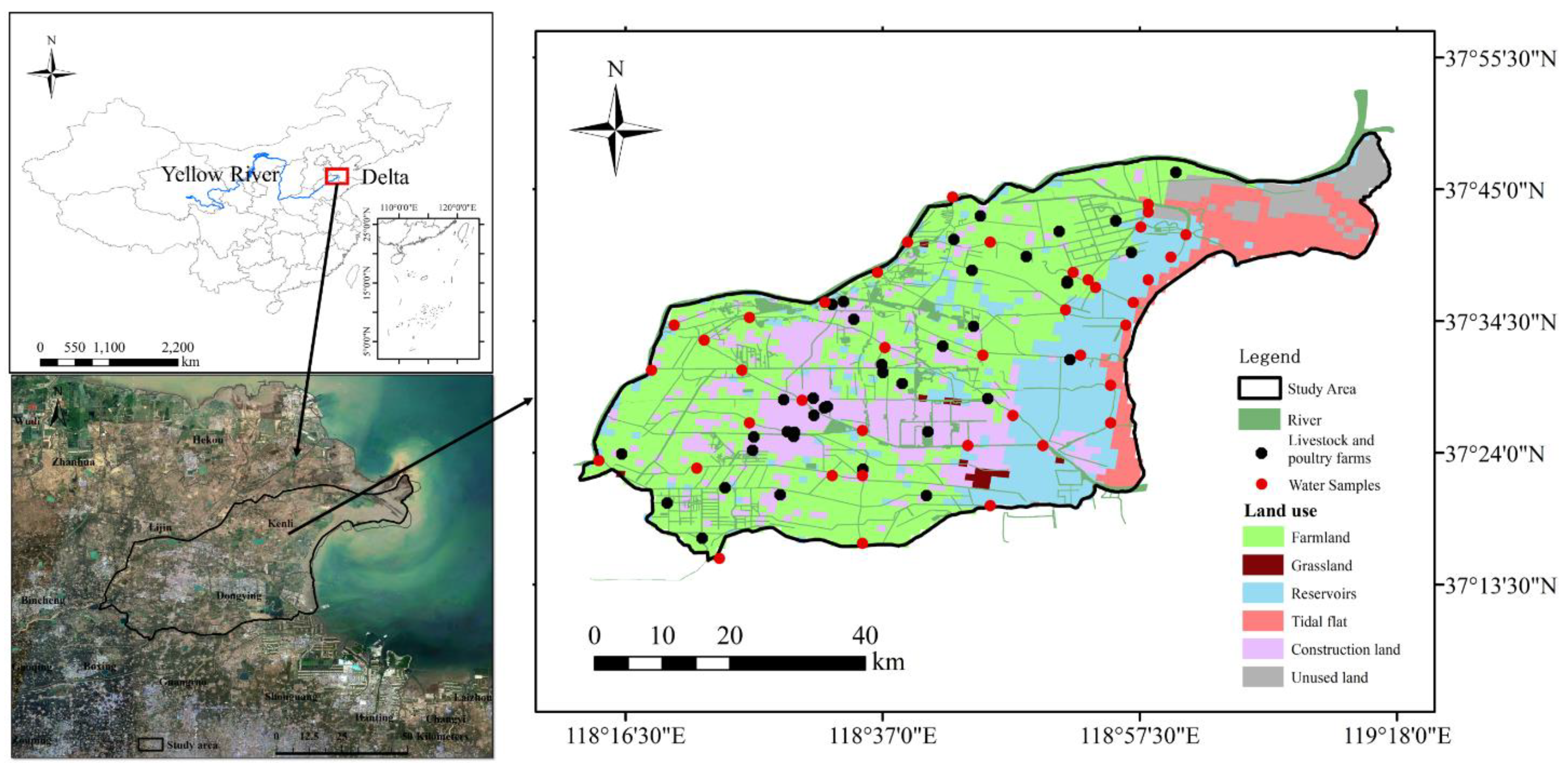
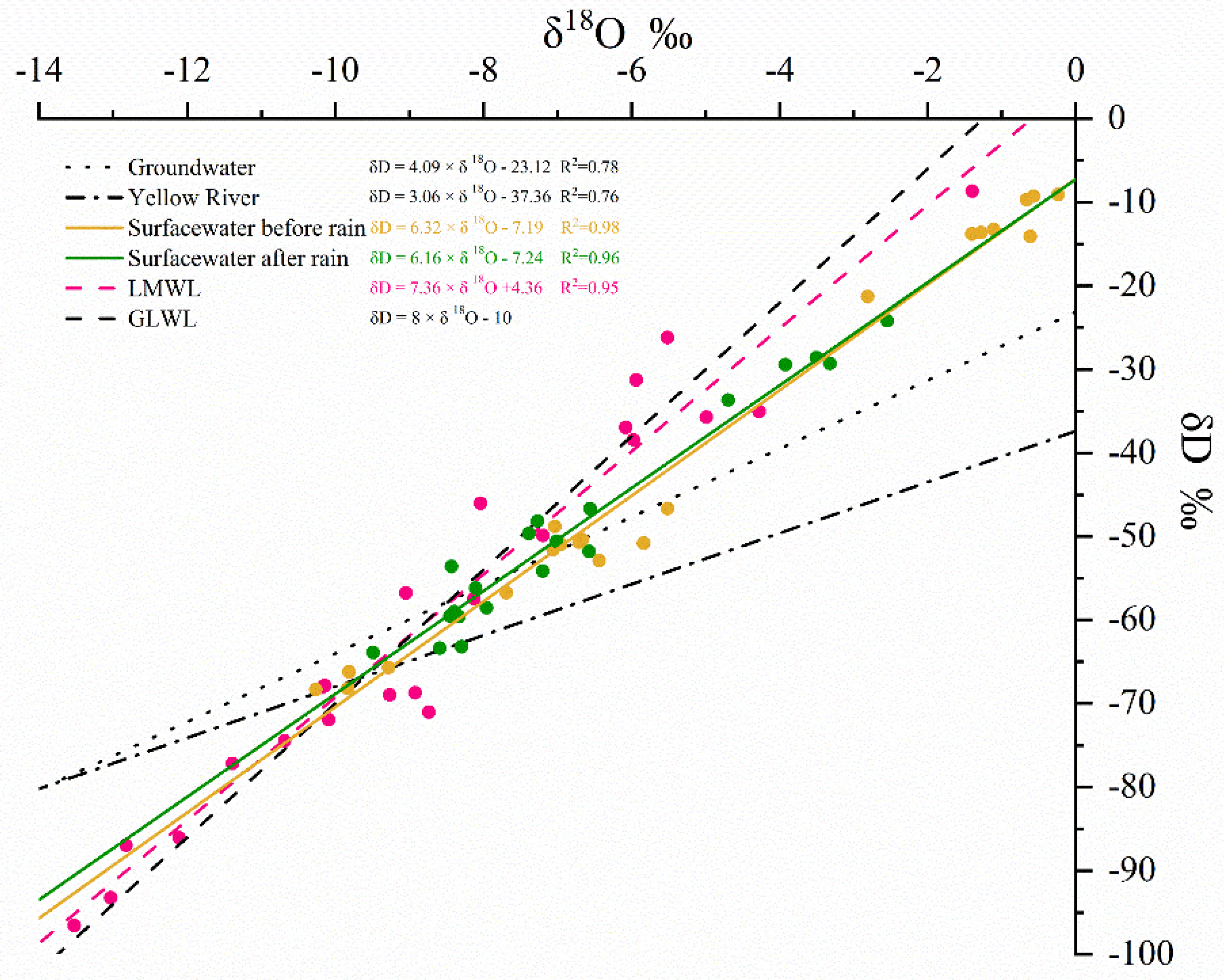
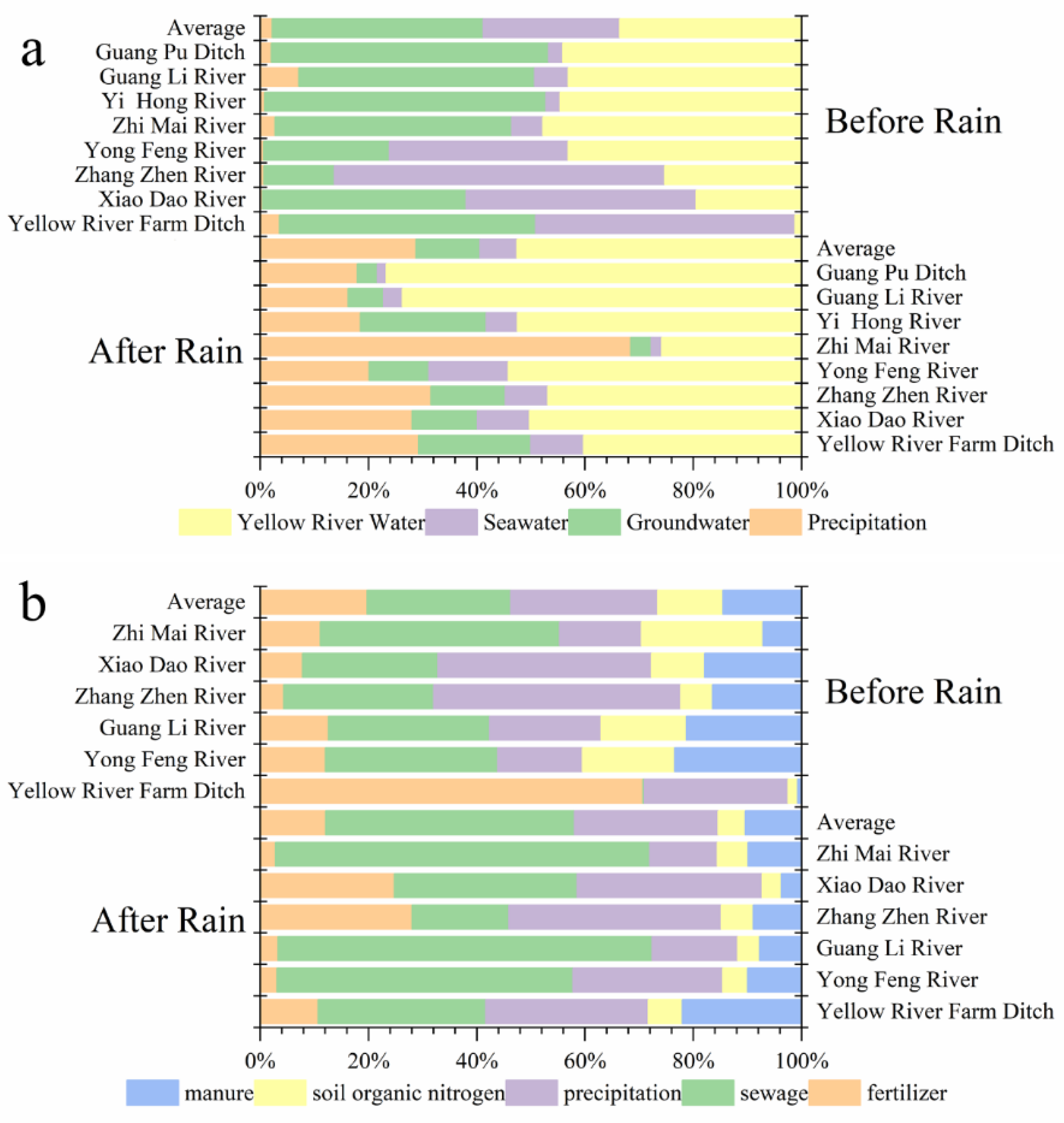
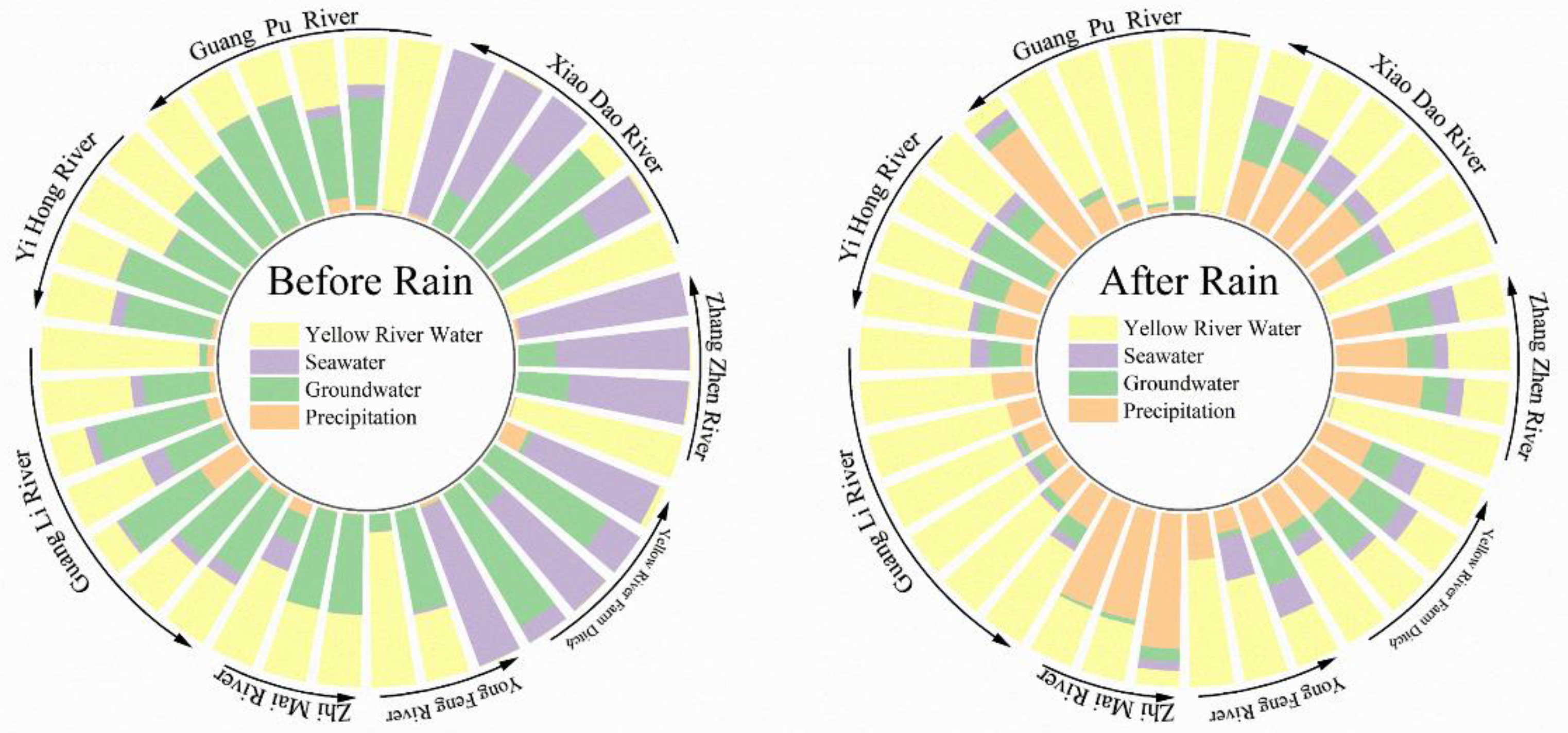
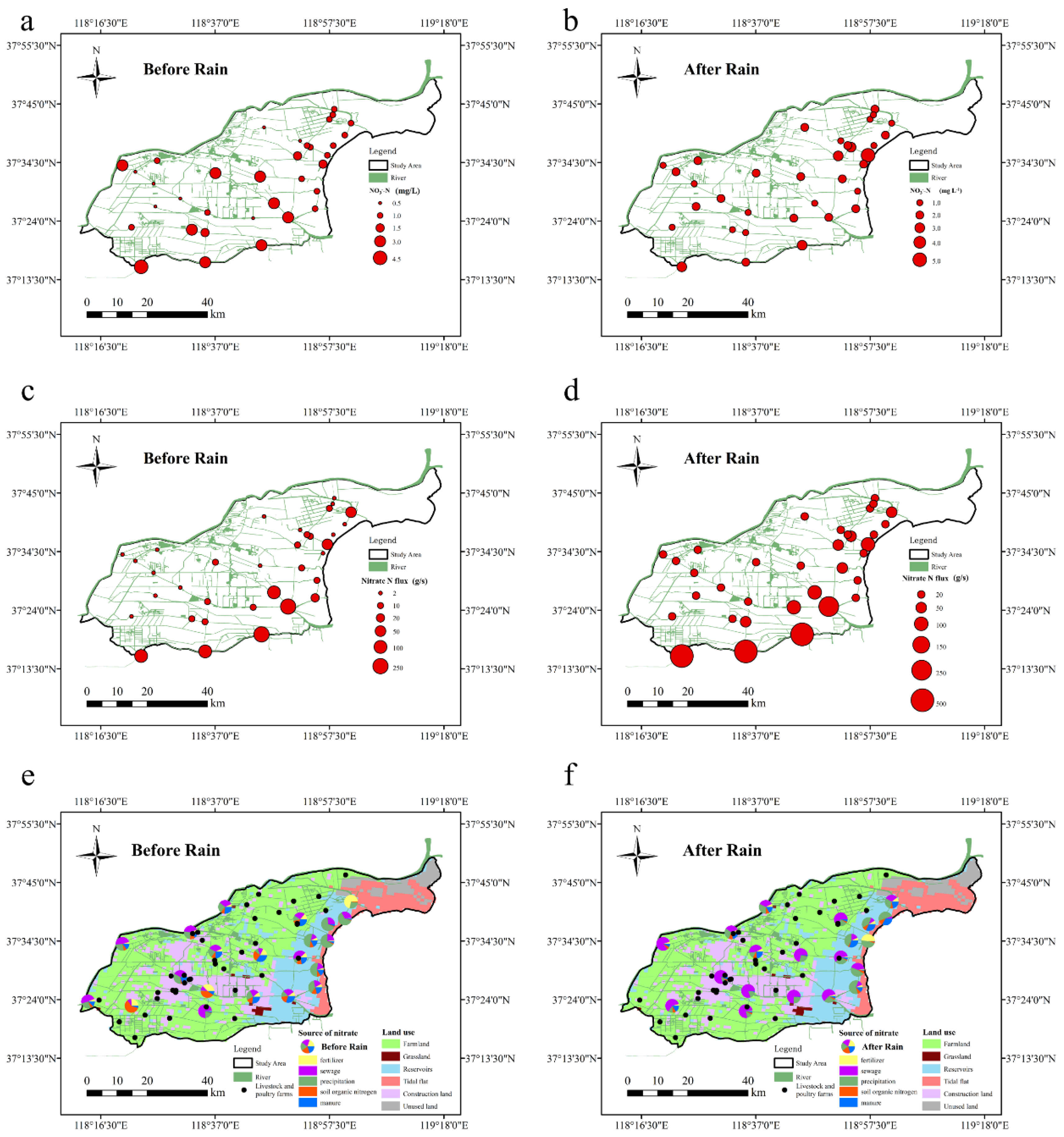
| Source | Mean δ15N | SD δ15N | Mean δ18O | SD δ18O |
|---|---|---|---|---|
| fertilizer | −2.1 | 0.7 | −4.1 | 2.7 |
| sewage | 17.4 | 3.9 | 6.1 | 1.6 |
| precipitation | 0.6 | 1.5 | 57.2 | 6.9 |
| soil organic nitrogen | 3.8 | 1.8 | −2.7 | 4.4 |
| manure | 9.3 | 4.4 | 7.4 | 7.2 |
| Month | River | Length | Watershed Area | Average [NO3−-N] | Nitrate N Flux | δD-H2O | δ18O-H2O | δ15N-NO3− | δ18O-NO3− |
|---|---|---|---|---|---|---|---|---|---|
| km | km2 | mg/L | g/s | ‰ | ‰ | ‰ | ‰ | ||
| Before Rain | Yellow River Farm Ditch | 18.80 | 100.00 | 0.70 | 34.18 | −29.43 | −2.93 | −1.52 | 12.21 |
| Xiao Dao | 27.50 | 120.80 | 0.95 | 21.45 | −31.70 | −3.14 | 6.46 | 24.86 | |
| Zhang Zhen | 28.00 | 140.00 | 1.47 | 21.45 | −30.64 | −3.47 | 6.75 | 28.68 | |
| Yong Feng | 33.80 | 200.00 | 1.93 | 3.87 | −44.24 | −5.44 | 8.19 | 11.70 | |
| Guang Li | 47.30 | 510.00 | 0.91 | 172.50 | −50.36 | −6.82 | 8.74 | 13.85 | |
| Zhi Mai | 135.00 | 3382.00 | 3.33 | 243.76 | −53.83 | −7.00 | 12.96 | 12.95 | |
| After Rain | Yellow River Farm Ditch | 18.80 | 100.00 | 0.95 | 49.33 | −51.35 | −7.58 | 7.63 | 20.07 |
| Xiao Dao | 27.50 | 120.80 | 2.16 | 85.40 | −52.15 | −7.89 | 5.89 | 20.76 | |
| Zhang Zhen | 28.00 | 140.00 | 3.09 | 85.40 | −53.40 | −8.03 | 3.67 | 22.83 | |
| Yong Feng | 33.80 | 200.00 | 1.80 | 30.38 | −53.72 | −7.69 | 11.29 | 20.04 | |
| Guang Li | 47.30 | 510.00 | 1.00 | 179.05 | −59.14 | −8.46 | 13.24 | 12.43 | |
| Zhi Mai | 135.00 | 3382.00 | 1.92 | 493.54 | −71.43 | −9.93 | 13.18 | 11.81 |
Publisher’s Note: MDPI stays neutral with regard to jurisdictional claims in published maps and institutional affiliations. |
© 2021 by the authors. Licensee MDPI, Basel, Switzerland. This article is an open access article distributed under the terms and conditions of the Creative Commons Attribution (CC BY) license (https://creativecommons.org/licenses/by/4.0/).
Share and Cite
Xie, H.; Huang, C.; Li, J.; Zhang, Y.; Xu, X.; Liu, D.; Ouyang, Z. Strong Precipitation and Human Activity Spur Rapid Nitrate Deposition in Estuarine Delta: Multi-Isotope and Auxiliary Data Evidence. Int. J. Environ. Res. Public Health 2021, 18, 6221. https://doi.org/10.3390/ijerph18126221
Xie H, Huang C, Li J, Zhang Y, Xu X, Liu D, Ouyang Z. Strong Precipitation and Human Activity Spur Rapid Nitrate Deposition in Estuarine Delta: Multi-Isotope and Auxiliary Data Evidence. International Journal of Environmental Research and Public Health. 2021; 18(12):6221. https://doi.org/10.3390/ijerph18126221
Chicago/Turabian StyleXie, Hanyou, Chong Huang, Jing Li, Yitao Zhang, Xiangbo Xu, Deyao Liu, and Zhu Ouyang. 2021. "Strong Precipitation and Human Activity Spur Rapid Nitrate Deposition in Estuarine Delta: Multi-Isotope and Auxiliary Data Evidence" International Journal of Environmental Research and Public Health 18, no. 12: 6221. https://doi.org/10.3390/ijerph18126221
APA StyleXie, H., Huang, C., Li, J., Zhang, Y., Xu, X., Liu, D., & Ouyang, Z. (2021). Strong Precipitation and Human Activity Spur Rapid Nitrate Deposition in Estuarine Delta: Multi-Isotope and Auxiliary Data Evidence. International Journal of Environmental Research and Public Health, 18(12), 6221. https://doi.org/10.3390/ijerph18126221







